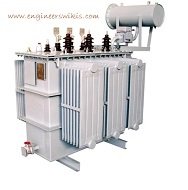
Transformers generate heat during their operation due to resistive losses in the windings and core. To prevent overheating and ensure the safe and efficient operation of transformers, various cooling methods are employed. The most common cooling methods for transformers include:
- Air Natural (AN): In this method, the transformer is cooled by natural convection of air. The transformer tank is designed with cooling fins or radiators to increase the surface area for heat dissipation. The ambient air circulates around the cooling surfaces, absorbing heat and carrying it away. Air natural cooling is suitable for smaller transformers with lower power ratings.
- Air Forced (AF) or Air Blown: This method involves using fans or blowers to force air over the cooling surfaces of the transformer. The fans increase the airflow, enhancing the cooling effect. Air forced cooling is more effective than air natural cooling and is suitable for larger transformers or situations where additional cooling is required.
- Oil Natural Air Natural (ONAN): This is one of the most common cooling methods for oil-immersed transformers. The transformer is immersed in insulating oil, which acts as both an electrical insulator and a cooling medium. Heat generated in the windings and core is transferred to the oil, and natural convection currents circulate the oil within the transformer tank. The heat is then dissipated to the surrounding air through the tank surface and cooling fins.
- Oil Forced Air Forced (OFAF): This cooling method combines oil circulation with forced air cooling. The transformer has an oil pump to circulate the oil through external radiators equipped with fans. The oil absorbs the heat from the windings and core and transfers it to the radiators, where the fans blow air over the cooling surfaces, facilitating heat dissipation.
- Oil Natural Air Forced (ONAF): In this method, the transformer relies on natural oil convection for cooling, while fans are used to force air over the cooling surfaces. The natural circulation of oil within the transformer tank carries away the heat, and the fans enhance the heat transfer by increasing the airflow. ONAF cooling is commonly used for medium to large-sized transformers.
- Oil Directed Air Forced (ODAF): This cooling method is a variation of ONAF cooling. It involves directing the flow of air over specific areas of the transformer using ducts or baffles. The directed airflow helps to improve the cooling efficiency by targeting the areas that generate the most heat.
The choice of cooling method depends on factors such as transformer size, power rating, operating conditions, and environmental considerations. Each cooling method has its advantages and limitations, and the appropriate method is selected to ensure optimal cooling, temperature control, and longevity of the transformer.
